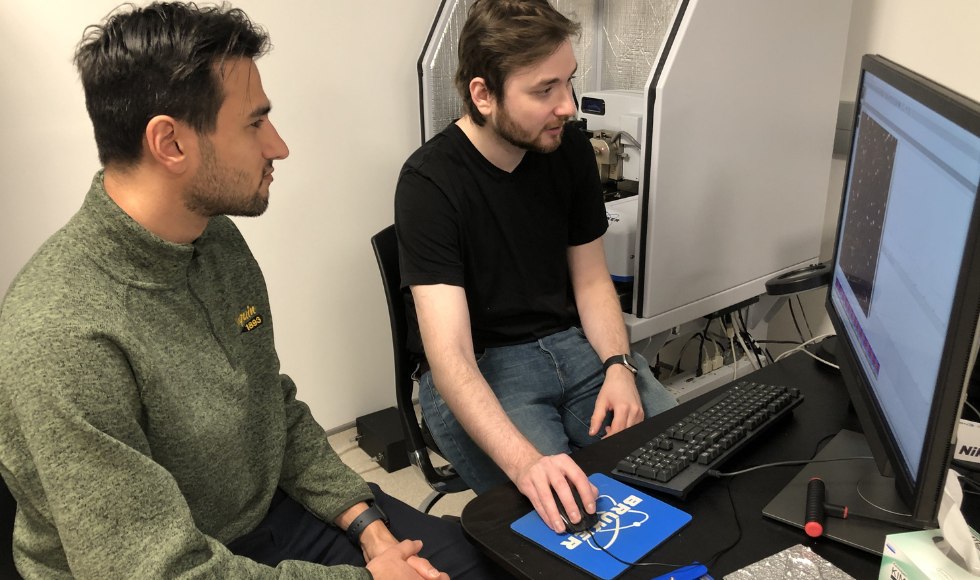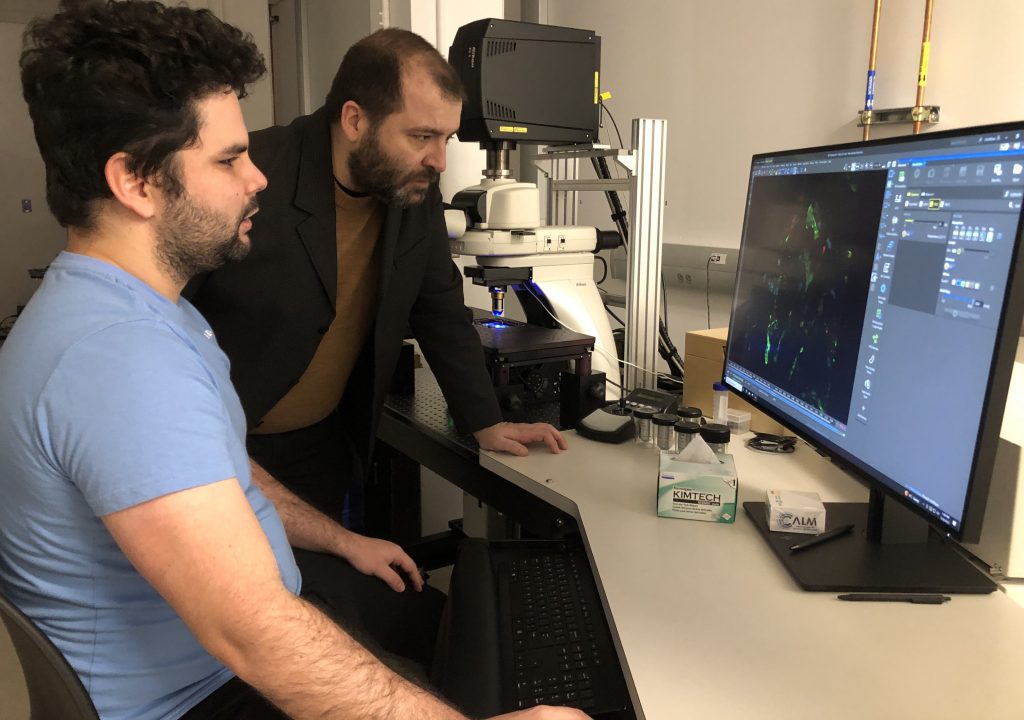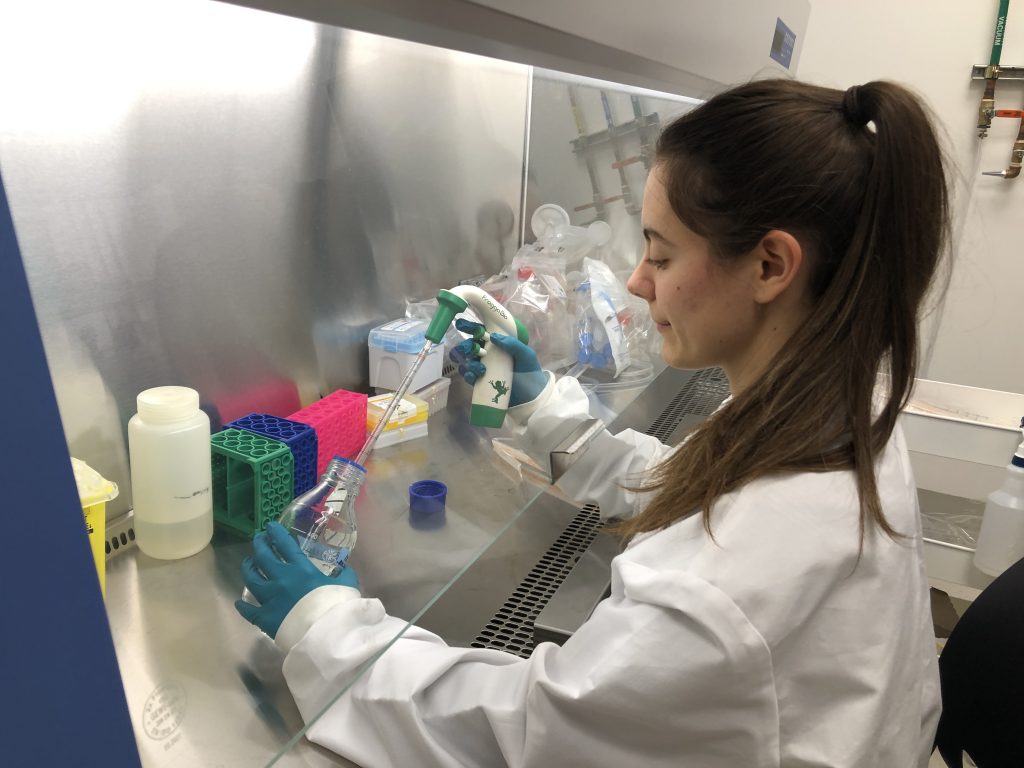Word gets out about McMaster’s unique microscopy centre

PhD student Mokhamed Ranne, right, works with imaging specialist Mouhanad Babi at the Centre for Advanced Light Microscopy, which offers a suite of 17 high-end microscopes, plus microfabrication and image analysis and a cell culture room.
BY Jay Robb, Faculty of Science
January 29, 2024
Mokhamed Ranne came for the microscopes and stayed for the expertise.
The PhD student is a Centre for Advanced Light Microscopy (CALM) regular. And he’s not alone. More than 100 research groups from across McMaster and beyond the university have used CALM.
“Word’s gotten out,” says scientific director Jose Moran-Mirabal.
The faculties of Science, Engineering and Health Sciences got together to open CALM in 2021. Located in the basement of the Arthur Bourns Building, the centre offers researchers 24/7 access to a suite of 17 high-end microscopes, plus microfabrication and image analysis and a cell culture room.
Some of CALM’s most advanced instruments aren’t available anywhere else in Ontario.
A bonus is CALM’s in-house expertise — Moran-Mirabal, facility manager Joao P.B. de Firmino and imaging specialist Mouhanad Babi. Combined, the trio have more than 35 years of microscopy experience.
“Research isn’t easy,” says Moran-Mirabal. “Small, overlooked details can trip you up and slow you down. We’re here to save researchers time while helping them acquire the best data.
“A world-class research university like McMaster deserves a world-class core research facility like CALM. That’s what we aim to deliver to every researcher who comes through our door.”
Ranne’s grateful for the help. A PhD student with chemistry and chemical biology Professor Alex Adronov’s research group, Ranne uses CALM’s atomic force microscope to visualize polymer distribution on carbon nanotubes.
“Microscopy techniques are easy to learn on a basic level but incredibly challenging to master. I’ve learned so much from the time I started using the instruments at CALM,” he says.
“The staff have been phenomenal in figuring out challenges and helping me work through the ins and outs of the microscopy techniques I’m using. Mouhanad and Joao drop by to check on how everyone’s doing.”
De Firmino and Babi take an interest in all the research to understand the different ways the instruments are being used, Ranne says.
“And then they share that knowledge to help other researchers. Mouhanad and Joao have offered me solutions or advice several times to overcome a hurdle that they knew worked for other researchers.”

David González-Martínez is another PhD student who’s a CALM booster. He’s developing new high-printability protein-based bioinks for extrusion 3D bioprinting. He uses CALM for cell visualization and protein expression quantification.
“The staff have been fundamental to my research,” he says. “They trained me on how to use the confocal microscope and taught me basic cell culture skills.”
De Firmino and Babi have gone far beyond providing basic services, he says.
“Whenever I’ve had a question, they’ve done everything they can to answer it. CALM plays a pivotal role in my work and it’s a cornerstone of my research.”
The gratitude goes both ways. “Every day we’re working with brilliant researchers and seeing some incredible images,” says de Firmino. “They’re taking microscopy to the next level and we get to witness it.”
The combination of world-class equipment and expertise is drawing attention. Moran-Mirabal says other universities and industry partners want to collaborate or replicate CALM’s success. “They’re looking to us to see how we’re doing it. We’re definitely on the map.”
Along with saving time, CALM saves money for research groups. Microscopes may be the workhorse of research but high-end equipment can be as pricey as thoroughbred racehorses to buy, maintain and repair. “We take care of all of that,” says de Firmino.
That’s earned CALM a reputation for reliability, says Moran-Mirabal. Service calls are few and far between. He says a commitment to training, maintenance and collaborations, like CALM’s strategic partnership with Nikon, have translated into one of the lowest down times for equipment at any core microscopy facility.
The centre’s mandate extends behind research and teaching to include service. The team introduced an imaging competition two years ago. They added a weeklong microscopy summer school this year.
“The school was a resounding success,” says Moran-Mirabal. They’d hoped for 50 participants, and more than 100 attendees from across Southern Ontario signed up to learn from leading microscopy experts from around the world.

Undergraduate student Julia Ungureanu helped run the summer school as an intern at CALM. The fifth-year IBioMed student then took the lead in an expansion microscopy project for the centre. Along the way, she got a crash course in how to use microscopes, process images, sustain cell lines and stain slides.
“Being around so many experts elevated my work and I’ve gained a lot of confidence when using CALM’s facilities.”
Along with picking up technical skills, Ungureanu says she also made great friends. “Sharing a coffee and lunch with the team was always a highlight of my day.”
Ungureanu, who’s also a Let’s Talk Science volunteer, spent part of her internship looking at how to get elementary and secondary school students excited about microscopy.
Connecting with children and teens will be a focus for CALM in 2024. “We want to inspire the next generation of microscopists,” says Moran-Mirabal.


